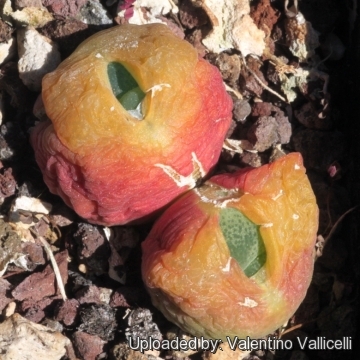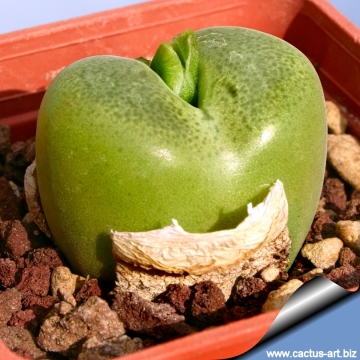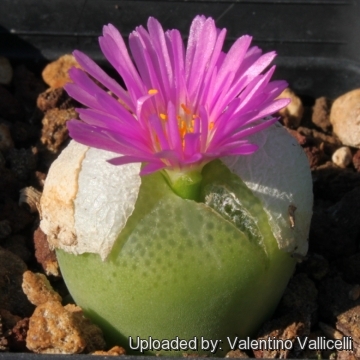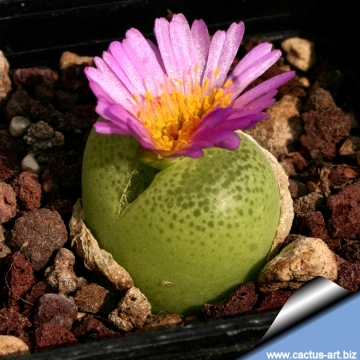Accepted Scientific Name: Conophytum subfenestratum Schwantes
Gartenwelt 33: 68 1929

Conophytum pillansii Photo by: Valentino Vallicelli
They are pale green, translucent and blooms in autumn.
Origin and Habitat: Knersvlakte - Namaqualand.
Synonyms:
See all synonyms of Conophytum subfenestratum
Common Names include:
ENGLISH: Living Pebbles
AFRIKAANS (Afrikaans): Glasvingertjies
CHINESE (中文): 翠光玉, 静明玉, 不死鳥
JAPANESE (日本語): ピランシー
Description: C. pillansii is one of the larger species, it stays single or (usually) clusters to form large cushion (Groundcover)
Body (leaves): Bodies soft, up to 2.5 cm in diameter and tall somewhat globose or nearly flat-topped, pale green, translucent, with many green spots, with a growing cleft that doesn't reach right across the body.
Flowers: Usually scented, large, daisy-like, purplish red, pink or, rarely, white, they are very showy.
Blooming season: Blooms mostly Aug-Nov.
Subspecies, varieties, forms and cultivars of plants belonging to the Conophytum subfenestratum group
 Conophytum pillansii Lavis ex L. Bolus: Bodies soft, up to 2.5 cm Ø, globose or nearly flat-topped, pale green, translucent, with many green spots. Is one of the larger species. Distribution: Knersvlakte, Western Cape.
Conophytum pillansii Lavis ex L. Bolus: Bodies soft, up to 2.5 cm Ø, globose or nearly flat-topped, pale green, translucent, with many green spots. Is one of the larger species. Distribution: Knersvlakte, Western Cape. Conophytum subfenestratum Schwantes: has rounded solitary or clustered bodies with the general appearance of a lithops, sunken into the ground, with only the flat top exposed. Distribution: Knersvlakte to Kliprand, Western Cape
Conophytum subfenestratum Schwantes: has rounded solitary or clustered bodies with the general appearance of a lithops, sunken into the ground, with only the flat top exposed. Distribution: Knersvlakte to Kliprand, Western Cape
Notes: Plants of the genus Conophytum are also known as 'living pebbles'. During the rest period (the summer months in Europe) a new body forms inside the old, gradually taking all the substances from it until all that remains is the skin, which dries and protects the young plant from the heat of the sun and excess evaporation of water. The resting Conophytum protected by this dry cover resembles a pebble and hence the name 'living pebble'. The growth period of most species is from August to March. The temperature should be about 10 to 12°C.
Bibliography: Major references and further lectures
1) Hermann Jacobsen “Lexicon of Succulent Plants” Littlehampton Book Services Ltd. 1974
2) Nicholas Edward Brown, A. Tischer, M. C. Karsten “Mesembryanthema; Descriptions: With Chapters on Cultivation and General Ecology” L. Reeve, 1931
3) Gordon D. Rowley “The illustrated encyclopedia of succulents” Crown Publishers, 01/Aug/1978
4) James Cullen, Sabina G. Knees, H. Suzanne Cubey “The European Garden Flora Flowering Plants: A Manual for the Identification of Plants Cultivated in Europe, Both Out-of-Doors” Cambridge University Press, 11/Aug./2011
5) Hammer, S. 1993. “The Genus Conophytum - A Conograph.” Succulent Plant Publications, Pretoria.
6) Hammer, S. 2002. “Dumpling and His Wife: New Views of the Genus Conophytum.” East Anglia Engraving Creative Colour Ltd, Norwich, England.
7) Ernst Van Jaarsveld, Ben-Erik Van Wyk, Gideon Smith “Succulents of South Africa: A Guide to the Regional Diversity” Tafelberg Publishers, Limited, 01/lug/2000
8) Heidrun E.K. Hartmann “Illustrated Handbook of Succulent Plants: Aizoaceae A-E” Springer, 2002
9) Werner Rauh “The Wonderful World of Succulents: Cultivation and Description of Selected Succulent Plants Other Than Cacti” Smithsonian Institution Press, 1984
 Conophytum pillansii Photo by: Cactus Art
Conophytum pillansii Photo by: Cactus Art Conophytum pillansii Photo by: Valentino Vallicelli
Conophytum pillansii Photo by: Valentino Vallicelli Conophytum pillansii Photo by: Cactus Art
Conophytum pillansii Photo by: Cactus Art Conophytum pillansii Photo by: Valentino Vallicelli
Conophytum pillansii Photo by: Valentino Vallicelli Conophytum pillansii Photo by: Cactus Art
Conophytum pillansii Photo by: Cactus Art Conophytum pillansii Photo by: Cactus Art
Conophytum pillansii Photo by: Cactus ArtCultivation and Propagation: C. pillansii is easy to grow. These plants grow on winter rain and head for summer dormancy. More or less dormant in summer. The plant requires little water; otherwise its epidermis breaks (resulting in unsightly scars). Water throughout the year although minimally in summer, (only when the plant starts shrivelling), but it will generally grow even in summer if given water. Water regularly in winter after the previous year's leaves have dried up. Requires good drainage. Keep cool and shaded from hot sun in mid-summer; it needs full sun or light shade in the other seasons. Hardy to -2°C. Ensure a very good ventilation. Avoid to repot frequently. This plant may stay in the same pot for many years. Plants grown in larger containers have frequently relatively poor flowers. It might improve when the plants are given their own, small individual pots.
Propagation: It can be reproduced both by cuttings and seeds. Take the cutting from a grown-up mother plant. Each cutting must contain one or more heads, along with a fraction of root.

















